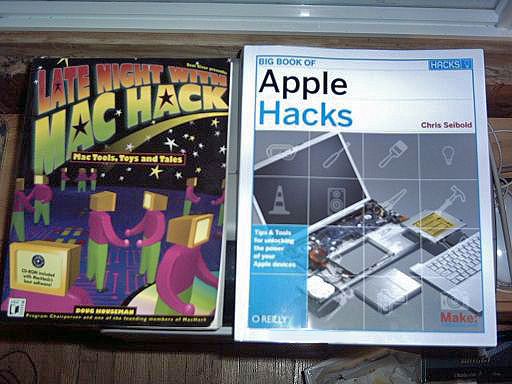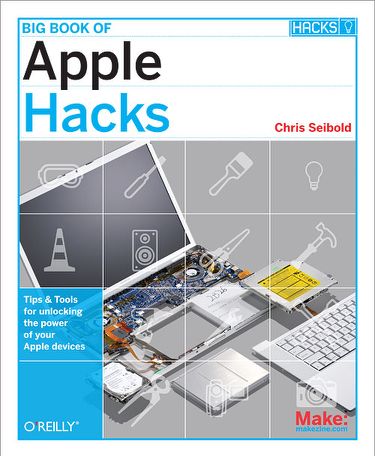‘Book Mystique Review - The Big Book Of Apple Hacks
Wednesday, May 14, 2008
by Charles W. Moore
There have been Mac Hacks books almost as long as there have been Macs. The first one in our house was a 1994 tome by Doug Houseman, then Program Chairman and one of the founding members of the Mac Hack conferences, called “Late Night With Mac Hack” - a compilation of some 100 hacks presented at the conferences and of course included the then-customary bundled CD containing some of the hacks discussed in the book. It was very popular with one of my progeny in particular.

The subject of this review, Chris Siebold’s hot-off-the-press Big Book Of Apple Hacks from the Make:Books imprint of O’Reilly Media, is a contemporary iteration of that same concept, only in this instance is a collection of hacks from the editors of MAKE magazine and O’ Reilly Media, including Siebold himself, a senior editor for the Apple Matters site.
The Big Book Of Apple Hacks title is accurately descriptive, as this is indeed a big book, containing a whopping 131 hacks arranged in 15 separate sections or “chapters.” It would take up virtually columns’ length just to list the individual hacks and briefly describe them, but a few examples that jumped out at me, sending me a diving into the text to check them out as I browsed the the table of contents included the several browser-oriented hacks (find a browser junkie), “Use That Software Restore Disk On (Almost) Any Mac;” “Free Up Gigabytes Of Space On Your Hard Drive (And Never Miss The Data),” “The 2¢ iPod Case,” “Build A Screaming Fast Darwin Machine For $935 (Or Less); “A Brighter Spotlight;” “Burn Leopard To A Single Disk;” “Install Leopard From An Image;” the whole 7 - hack section on hacks for laptops, “Legal Online Sources For Music (Besides iTunes!)” And “No Lights? No Power? Still Got The Net!”
And of course those are just a small sampling of what’s included in this book. There are sections on hacks for the Internet, OS X itself, command-line hacks, network and security hacks, hacks for the iPod, iPhone, and even Apple TV, hacking iLife applications, multimedia hacks, and multiple operating systems hacks. What ever your interest with the Mac, you should be able to find plenty to interest you in this book.
The book is set up for reference browsing rather than cover-to-cover reading, so except perhaps for the introductory chapters there’s no “right” place to dive in, since each hack is intended to be as self-contained as possible and will point to where you need to go if it isn’t. Since some of the hacks depend on command-line entry, Chapter 4, “Command-Line Fun,” (which you can also check out on line from the sample chapter link below) is probably worth checking out early on, especially if you’re a bit rusty in that department. Not being much of a command-line jock myself (I have trouble remembering 6-word passwords, let alone strings of code!), I don’t find the hacks requiring command-line manipulations especially enticing, but perhaps I can be brought up to speed.
“Most of the hacks in the book are answers to questions or problems people have had when using their Apple products,” says Siebold, noting that “one of my favorite hacks is from a contributor, (Rich Lefko). After he left a job, he wanted to keep his work data - he used a PC at work, without having to buy a Windows PC. Rick’s hack was brilliant. He discovered a way to swap the hard drive of the MacBook and install the hard drive from work and boot into Windows. So now, on the rare occasions he wants a Windows machine, he just switches out the drive in his MacBook.”
Cool trick, but it should be noted that it is essentially limited to 13-inch MacBook users, thanks to that machine’s unusually easy access to the hard drive, which can be swapped in a minute or so.
As I observed, the The Big Book Of Apple Hacks is, well, a big book, described by the publisher as “bigger in size, longer in length, and broader in scope.” It has a larger footprint than even the formidable O’Reilly published “Missing Manuals” books, 616 pages of text content plus another 10 pages of index, and as noted, it spans the Apple hardware and software spectrum from iPod to Mac Pro and OS X to iTunes.

The book’s designed is attractive - I especially like the very pleasant-looking cover in predominantly blue and white, with a photo of a dismembered MacBook Pro on the front.
Inside, the page layout and design are quite reminiscent of the style of the Missing Manual books, although with a smaller font (maybe a bit smaller than I would prefer, being a stubborn hold them resisting the bifocals I have been told I should be wearing), and if it had been my decision, I would have opted for a couple of points larger font and made room with less white space. Indeed, the book could have been made substantially smaller and easier to heft without any change in content whatsoever simply by whopping off three quarters of an inch or so of white space.
Most of the hacks are copiously illustrated with screenshots and photos in grayscale, with Quick Tip, Quick Note, and Quick Hack sidebar boxes appearing frequently in the margins.
While the formidable size and weight of this volume are not my favorite feature, the content is strong, and should keep any hands-on tech-oriented Mac user engrossed. The price is perhaps a little steep at $34.95 (US and Canada), but f you get a lot of content for your money, and some of the information included will almost certainly save you money in other contexts.
The Big Book of Apple Hacks
Tips & Tools for unlocking the power of your Apple devices
By Chris Seibold
First Edition April 2008
Pages: 640
Series: Hacks
ISBN 10: 0-596-52982-1
ISBN 13: 9780596529826
Price: $34.99 USD/£21.99 GBP
For more information, visit:
http://www.oreilly.com/catalog/9780596529826/
Sample Chapter
Command-Line Fun (PDF Format)
http://www.oreilly.com/catalog/9780596529826/chapter/index.html
Note: Letters to PowerBook Mystique Mailbag may or may not be published at the editor's discretion. Correspondents' email addresses will NOT be published unless the correspondent specifically requests publication. Letters may be edited for length and/or context.
Opinions expressed in postings to PowerBook Mystique MailBag are owned by the respective correspondents and not necessarily shared or endorsed by the Editor and/or PowerBook Central management.
If you would prefer that your message not appear in PowerBook Mystique Mailbag, we would still like to hear from you. Just clearly mark your message "NOT FOR PUBLICATION," and it will not be published.
CM